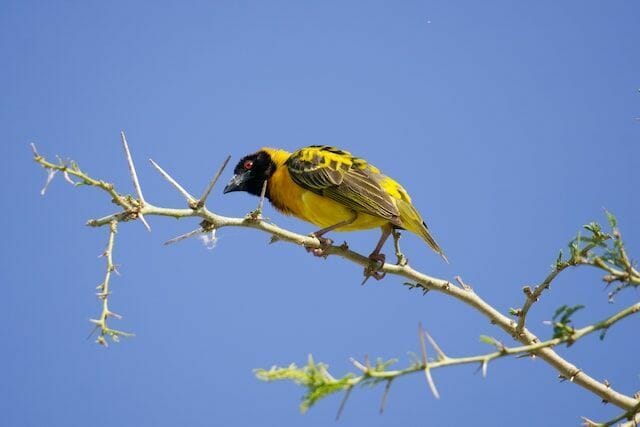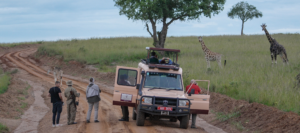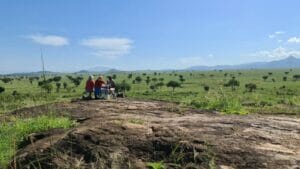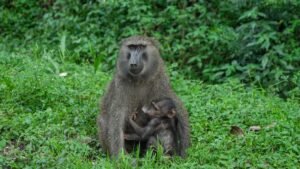Welcome to the captivating world of birdwatching in Uganda, a country renowned for its remarkable avian diversity and stunning natural landscapes.
Nestled in the heart of East Africa, Uganda offers a birdwatching experience like no other, with its rich biodiversity, unique ecosystems, and a plethora of endemic and rare bird species.
Whether you are a seasoned birder or a novice enthusiast, Uganda is a prime destination that will undoubtedly leave you awe-inspired.
- Why Uganda is a Prime Birdwatching Destination
- Brief Overview of Uganda’s Geographic and Ecological Features
- Understanding the Birdwatching Season in Uganda
- Best Places To Go Birdwatching in Uganda
- Uganda’s Diverse Avian Species
- Bird Identification Tips for Beginners in Uganda
- Conservation Status of Birds in Uganda
- Planning Your Birdwatching Trip to Uganda
- Exploring Uganda’s Top Birdwatching Destinations
- Bwindi Impenetrable National Park: Home to the Elusive Albertine Rift Endemics
- Queen Elizabeth National Park: Rich Avian Diversity in Diverse Habitats
- Murchison Falls National Park: A Paradise for Waterbirds and Raptors
- Kibale National Park: Discovering Uganda’s Forest Birdlife
- Semuliki National Park: Exploring the Albertine Rift’s Avian Treasures
- Tips and Techniques for Birdwatching in Uganda
- Essential Birdwatching Equipment to Pack for Uganda
- Field Guide Recommendations for Bird Identification in Uganda
- Understanding Bird Calls and Songs in Uganda
- Bird Photography Tips and Etiquette in Uganda
- Responsible Birdwatching Practices and Conservation Initiatives in Uganda
- Conservation Initiatives and Ecotourism in Uganda
- The Role of Ecotourism in Bird Conservation
- Sustainable Tourism Practices in Uganda
- Book Your Next Uganda Birdwatching Tour With Kikooko Africa Safaris
Why Uganda is a Prime Birdwatching Destination
Uganda’s reputation as a top birdwatching destination stems from its exceptional geographical location and diverse habitats.
Situated at the crossroads of the East African savannah, West African rainforests, and the Great Rift Valley, the country boasts an incredibly diverse range of ecosystems, from dense forests and wetlands to expansive grasslands and towering mountains.
These varied landscapes provide an ideal habitat for an impressive array of bird species, making Uganda a true haven for avian enthusiasts.
Brief Overview of Uganda’s Geographic and Ecological Features
Covering an area of approximately 241,038 square kilometers, Uganda is bordered by South Sudan to the north, Kenya to the east, Tanzania and Rwanda to the south, and the Democratic Republic of Congo to the west. Within its borders lies an extraordinary tapestry of geographical features, including the snow-capped Rwenzori Mountains, the vast Lake Victoria, and the mighty Nile River, which originates from Lake Victoria and cascades through Murchison Falls.
Uganda’s ecological diversity is equally remarkable. The country boasts a range of habitats, from the dense rainforests of Bwindi Impenetrable National Park to the expansive savannahs of Queen Elizabeth National Park. These diverse ecosystems support a rich and varied avifauna, making Uganda an ideal destination for birdwatchers seeking a wide range of species and habitats to explore.
Birdwatching in Uganda is not only a thrilling and rewarding experience but also plays a crucial role in conservation efforts. As a country with a high concentration of endemic and threatened bird species, Uganda relies on birdwatchers to help monitor and protect its avian populations.
By engaging in responsible birdwatching practices, enthusiasts contribute to ongoing research, conservation initiatives, and awareness campaigns aimed at preserving Uganda’s unique birdlife and its fragile ecosystems.
Understanding the Birdwatching Season in Uganda
To fully appreciate the birdwatching opportunities in Uganda, it is essential to understand the seasonal variations that impact birdlife.
The country experiences two primary seasons: the dry season, which runs from December to February and June to August, and the wet season, occurring from March to May and September to November.
Each season offers its own advantages, with the dry season providing clearer views and easier accessibility to certain areas, while the wet season brings lush vegetation and increased bird activity. Careful consideration of the birdwatching season will help optimize your chances of encountering the desired species and enjoying the best possible birding experience.
Best Places To Go Birdwatching in Uganda
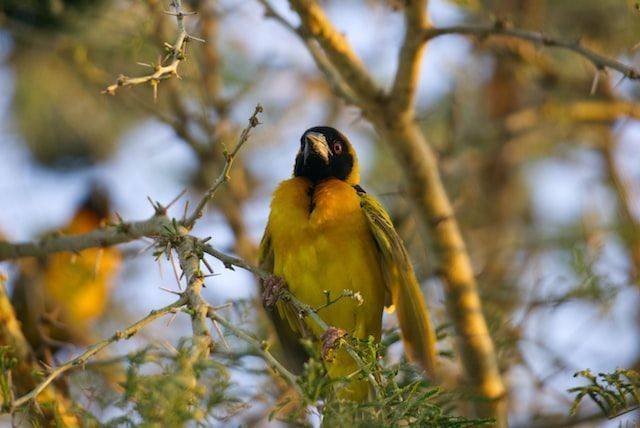
Uganda is blessed with numerous birdwatching hotspots, each offering a unique blend of avian treasures. From the dense montane forests to the sprawling savannahs, these locations provide birders with a chance to observe an impressive variety of species in their natural habitats.
Some of the notable hotspots include Bwindi Impenetrable National Park, Queen Elizabeth National Park, Murchison Falls National Park, Kibale National Park, and Semuliki National Park. These parks have been carefully selected based on their exceptional bird diversity and the opportunities they offer for remarkable birdwatching experiences.
As we embark on this comprehensive journey into the world of birdwatching in Uganda, prepare to be enthralled by the enchanting melodies, vibrant plumages, and breathtaking landscapes that await you. Whether you are fascinated by the elusive Albertine Rift endemics or captivated by the graceful waterbirds and raptors, Uganda promises an unforgettable adventure for every birdwatching enthusiast. So, grab your binoculars and join us as we unravel the secrets of this avian paradise.
Uganda’s Diverse Avian Species
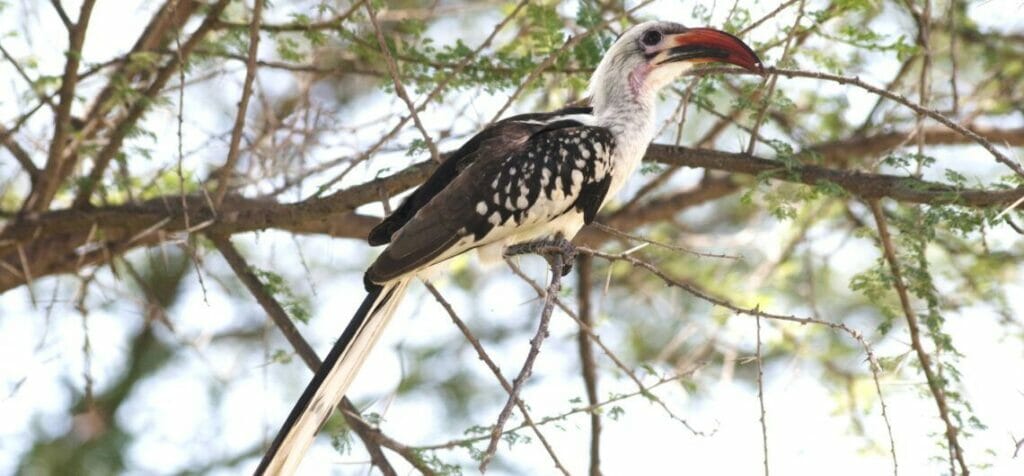
Uganda’s avian diversity is a true marvel, attracting birdwatchers from around the globe. With over 1,000 bird species recorded, the country boasts a remarkable range of feathered inhabitants, making it a birdwatcher’s paradise. From colorful and endemic species to migratory birds that traverse vast distances, Uganda offers a captivating diversity that is sure to leave birding enthusiasts in awe.
Uganda’s bird species diversity is truly astounding. The country is home to a wide range of families, including passerines, raptors, waterbirds, and many more. Whether you are passionate about spotting brightly colored sunbirds, elusive owls, or majestic cranes, Uganda has something to offer for every bird enthusiast.
One of the highlights of birdwatching in Uganda is the presence of numerous endemic species. The Albertine Rift, a unique region characterized by its mountains and valleys, is a hotspot for these endemic birds. Species such as the African Green Broadbill, Grauer’s Rush Warbler, and Shelley’s Crimsonwing can only be found in this region, making it a must-visit for birdwatchers seeking rare and exclusive sightings.
Highlighting Endemic and Rare Birds in Uganda
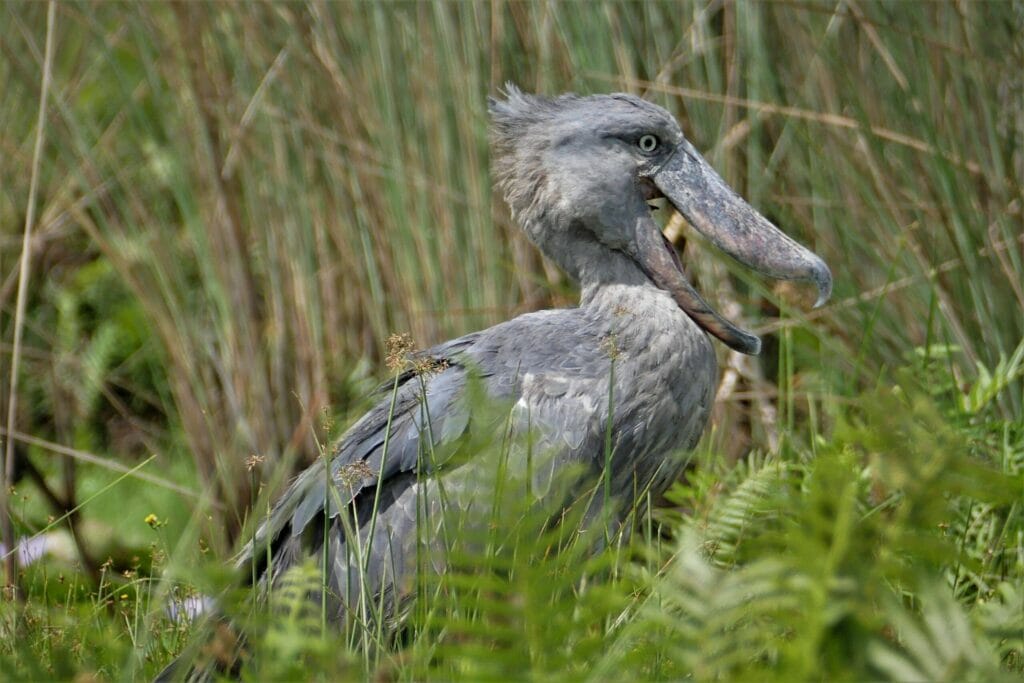
Uganda’s endemic birds are a testament to the country’s ecological significance and the need for their conservation. In addition to the Albertine Rift endemics, Uganda is also home to other rare and sought-after species.
The Shoebill, a prehistoric-looking bird with a distinct shoe-shaped bill, can be found in the swamps and wetlands of Uganda. This enigmatic bird, often referred to as the “whale-headed stork,” is a true icon of Ugandan birdlife.
Other notable species include the African Grey Crowned Crane, Uganda’s national bird, with its striking plumage and dancing displays, and the African Fish Eagle, known for its impressive hunting prowess and iconic call that echoes across Uganda’s lakes and rivers. These and many other rare and endemic species make Uganda a prime destination for birdwatchers seeking memorable and unique encounters.
Understanding Bird Migration Patterns in Uganda
Uganda’s strategic location along bird migration routes adds another layer of excitement to birdwatching. Each year, millions of migratory birds travel to and through Uganda, seeking suitable breeding grounds, feeding opportunities, or favorable climates. The country’s diverse habitats provide essential stopover points for these migratory species, offering birdwatchers a chance to witness impressive flocks on their journey.
The wetlands and national parks in Uganda become vibrant with activity during the migratory seasons. From the European Bee-eaters and Eurasian Rollers to the White Storks and Steppe Eagles, these visitors from afar paint the skies and enrich Uganda’s avian tapestry. Understanding the timing and patterns of bird migration can greatly enhance the birdwatching experience, as enthusiasts can plan their visits to coincide with peak migration periods.
Bird Identification Tips for Beginners in Uganda
For novice birdwatchers, identifying the vast array of species in Uganda can be a daunting task. However, with a few key tips and techniques, beginners can quickly develop their skills and deepen their appreciation for the avian wonders of Uganda.
One of the first steps is to invest in a reliable field guide specific to Uganda’s bird species. A comprehensive guide will provide detailed descriptions, illustrations, and range maps for easy reference. It is also helpful to familiarize oneself with common bird families and their distinguishing characteristics, such as beak shape, plumage patterns, and habitat preferences.
Listening to bird calls and songs is another valuable skill for bird identification. Many bird species have distinct vocalizations that can aid in identification, even when the birds themselves are hidden from view. Online resources or mobile applications featuring bird songs can be immensely helpful in learning and recognizing different vocalizations.
Patience and observation are key when birdwatching in Uganda. Taking the time to carefully study a bird’s behavior, feeding habits, and flight patterns can provide valuable clues for identification. Binoculars or spotting scopes are indispensable tools for observing birds up close and appreciating their intricate details.
Conservation Status of Birds in Uganda
Conservation efforts play a vital role in protecting Uganda’s rich avian diversity. Several bird species in the country are classified as globally threatened or near-threatened due to habitat loss, poaching, and other anthropogenic factors. Birdwatching in Uganda not only allows enthusiasts to appreciate these remarkable creatures but also contributes to their conservation.
By supporting responsible tourism initiatives, birdwatchers help generate revenue for protected areas and local communities, encouraging sustainable practices and habitat preservation. Engaging with local conservation organizations and participating in citizen science projects can also contribute to monitoring bird populations, tracking migration patterns, and identifying priority conservation areas.
Uganda’s commitment to conservation is evident through the establishment of protected areas, such as national parks and wildlife reserves, which serve as sanctuaries for birds and other wildlife. These protected areas play a crucial role in safeguarding habitats and ensuring the long-term survival of Uganda’s avian treasures.
As we delve deeper into the enchanting realm of birdwatching in Uganda, it is essential to appreciate the incredible diversity of bird species that call this country home. From endemic and rare birds to migratory species passing through, Uganda’s avian inhabitants offer a captivating spectacle for birdwatchers of all levels. Whether you are an experienced birder or just beginning your journey, Uganda’s remarkable feathered residents are sure to leave an indelible mark on your birdwatching adventures. So, grab your binoculars, pack your sense of wonder, and let us explore the avian wonders of Uganda together.
Planning Your Birdwatching Trip to Uganda
Planning a birdwatching trip to Uganda requires careful consideration and preparation to ensure a successful and fulfilling experience. From choosing the right time to visit to arranging accommodations and transportation, thoughtful planning can enhance your chances of encountering a wide variety of bird species and enjoying the beauty of Uganda’s natural landscapes.
Best Time to Visit Uganda for Birdwatching
Determining the best time to visit Uganda for birdwatching largely depends on your specific interests and target species. The country’s diverse habitats and climate variations offer unique opportunities throughout the year. However, certain seasons may be more favorable for specific bird sightings or experiences.
The dry season, which occurs from December to February and June to August, is generally considered the peak birdwatching season in Uganda. During this time, the weather is relatively dry, making it easier to navigate through the national parks and reserves. The foliage is less dense, providing better visibility of the birds. Additionally, the dry season coincides with the breeding season for many species, offering opportunities to witness courtship displays and nesting behaviors.
On the other hand, the wet season, from March to May and September to November, brings lush greenery and an abundance of food sources, attracting a higher number of birds. Migratory species, such as raptors and waterbirds, can be observed during their stopovers. However, it is important to note that some areas may become inaccessible due to heavy rains and muddy conditions.
Ultimately, the best time to visit Uganda for birdwatching depends on your personal preferences and the specific species you wish to encounter. Consider consulting with local birdwatching experts or tour operators to determine the optimal timing based on your interests and desired sightings.
Obtaining the Required Travel Documents
Before embarking on your birdwatching adventure in Uganda, it is essential to ensure that you have all the necessary travel documents in order. These may include a valid passport, visa, and any required vaccinations or health certificates.
Ensure that your passport is valid for at least six months beyond your planned departure date from Uganda. Check the visa requirements for your country of residence and apply accordingly. Depending on your nationality, you may be able to obtain a visa upon arrival at Entebbe International Airport, or you may need to apply in advance through the Ugandan embassy or consulate in your home country.
It is also advisable to consult with your healthcare provider or a travel clinic to determine if any vaccinations or preventive medications are recommended for your visit to Uganda. Common vaccinations for travelers to Uganda include those for yellow fever, typhoid, hepatitis A and B, and tetanus. Additionally, malaria is prevalent in some parts of Uganda, so antimalarial medication may be necessary. It is important to consult with a healthcare professional to determine the most appropriate preventive measures based on your individual health and travel history.
Choosing the Right Birdwatching Tour Operator in Uganda
Selecting a reputable birdwatching tour operator is essential for a smooth and enriching experience in Uganda. A knowledgeable and experienced tour operator can provide expert guidance, arrange logistics, and offer valuable insights into the country’s avian biodiversity.
When choosing a tour operator, consider their track record, customer reviews, and expertise in birdwatching. Look for operators with a deep understanding of Uganda’s birdlife, extensive local networks, and a commitment to responsible and sustainable tourism practices. They should prioritize the well-being of the birds and their habitats, ensuring that your birdwatching activities have minimal impact on the environment.
Additionally, consider the services offered by the tour operator. A comprehensive package may include transportation, accommodations, knowledgeable guides, and access to prime birdwatching locations. Ensure that the itinerary aligns with your interests and desired bird sightings. Customizable options are often available, allowing you to tailor the trip to your specific preferences and birding goals.
Selecting the Ideal Birdwatching Itinerary in Uganda
Uganda offers a wealth of birdwatching opportunities across its various national parks, reserves, and wetlands. When planning your Uganda birdwatching itinerary, consider the specific habitats and bird species you wish to explore. Research the key birdwatching hotspots and their respective seasons to optimize your chances of encountering your target species.
Bwindi Impenetrable National Park, for example, is renowned for its population of Albertine Rift endemics, including the highly sought-after African Green Broadbill and the vibrant Regal Sunbird. Queen Elizabeth National Park is famous for its diverse ecosystems, which attract a wide range of bird species, including raptors, waterbirds, and forest-dwelling birds.
Murchison Falls National Park offers a unique combination of savannah and riverine habitats, providing opportunities to spot iconic species such as the African Fish Eagle, Goliath Heron, and Saddle-billed Stork. Kibale National Park, on the other hand, is a paradise for forest birdwatching, with species like the Green-breasted Pitta and African Pitta captivating birders with their colorful plumage and unique calls.
When planning your itinerary, consider the duration of your trip and the logistics involved in reaching different birding locations. Depending on your time constraints and interests, you may choose to focus on specific regions or combine multiple parks for a more comprehensive birdwatching experience.
Planning for Accommodation and Transportation in Uganda
Accommodation and transportation are crucial aspects of your birdwatching trip to Uganda. Depending on your preferences and budget, a range of options is available, from luxury lodges and eco-camps to budget-friendly guesthouses and campsites.
Many national parks in Uganda offer lodging options within or nearby their boundaries, providing convenient access to prime birdwatching areas. These accommodations often boast scenic locations, knowledgeable staff, and amenities that cater to the needs of birdwatchers, such as bird hides and expert guides.
Planning for accommodation and transportation well in advance is advisable, especially during peak birdwatching seasons when availability may be limited. Research and book accommodations that align with your itinerary and budget, and confirm transportation arrangements to ensure a seamless and enjoyable birdwatching experience in Uganda.
As you embark on the exciting journey of planning your birdwatching trip to Uganda, careful consideration of timing, travel documents, tour operators, itineraries, accommodations, and transportation will help create a seamless and unforgettable experience. By making informed decisions and preparations, you can maximize your chances of encountering Uganda’s diverse avian species and immersing yourself in the breathtaking beauty of this East African gem.
Exploring Uganda’s Top Birdwatching Destinations
Uganda is blessed with an abundance of breathtaking landscapes and diverse habitats, providing a haven for numerous bird species. From dense rainforests to expansive savannahs, the country’s top birdwatching destinations offer a wealth of avian treasures waiting to be discovered. Let’s explore some of the must-visit locations that will satisfy every birdwatcher’s quest for remarkable sightings and memorable experiences.
Bwindi Impenetrable National Park: Home to the Elusive Albertine Rift Endemics
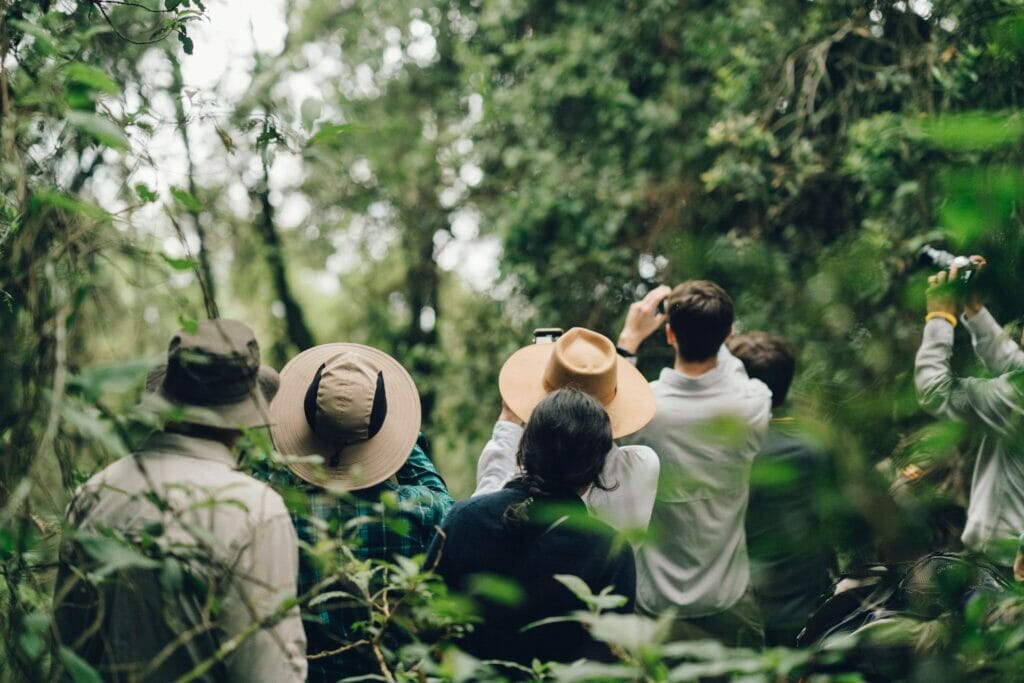
Nestled in southwestern Uganda, Bwindi Impenetrable National Park is a UNESCO World Heritage Site and a critically important birdwatching destination. The park’s dense montane forests are not only home to almost half of the world’s remaining mountain gorillas but also harbor an impressive array of bird species, including many Albertine Rift endemics.
Birdwatchers visiting Bwindi can expect to encounter elusive and rare species such as the African Green Broadbill, which is known for its emerald-green plumage and unique foraging behavior. Other notable species include the Handsome Francolin, Grauer’s Rush Warbler, and the vibrant Regal Sunbird. The melodious songs of the Ruwenzori Batis and the Rwenzori Turaco add to the magical ambiance of this birding paradise.
Exploring Bwindi Impenetrable National Park requires a permit, which is obtained through the Uganda Wildlife Authority. It is advisable to book permits well in advance, as demand is high, especially during peak birdwatching seasons. Local guides are available to accompany birdwatchers, providing valuable insights and assistance in spotting and identifying the park’s avian residents.
Queen Elizabeth National Park: Rich Avian Diversity in Diverse Habitats

Situated in western Uganda, Queen Elizabeth National Park is a true gem for birdwatchers. Spanning over 1,978 square kilometers, the park encompasses a variety of habitats, including savannah grasslands, wetlands, and forests, which support an incredible diversity of bird species.
The Kazinga Channel, a natural waterway that connects Lake Edward and Lake George, is a hotspot for waterbirds, including the iconic African Fish Eagle, Goliath Heron, and the majestic Saddle-billed Stork. The park’s Ishasha sector is renowned for its tree-climbing lions and is also home to the African Skimmer, a unique bird species that skims the water’s surface while feeding.
In the Mweya Peninsula area of Queen Elizabeth National Park, birdwatchers can explore the Kasenyi Plains, where a variety of grassland species can be spotted, including the elegant Secretary Bird, Southern Ground-Hornbill, and the vibrant Black-bellied Bustard.
For those interested in forest birding, the Maramagambo Forest offers a chance to encounter species such as the Papyrus Gonolek, White-winged Warbler, and the African Broadbill. The diverse habitats of Queen Elizabeth National Park ensure a captivating birdwatching experience for enthusiasts of all levels.
Murchison Falls National Park: A Paradise for Waterbirds and Raptors
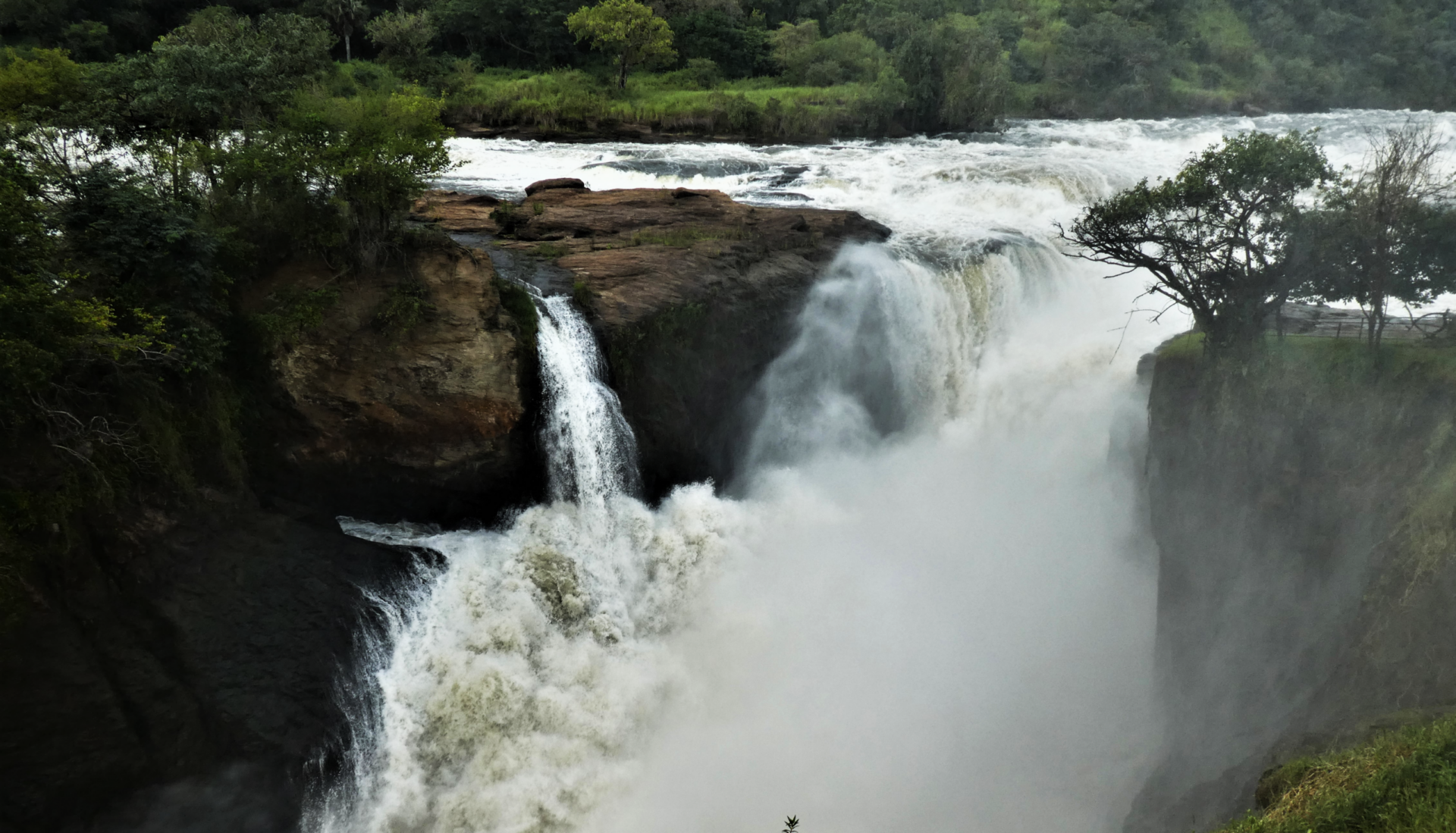
Located in northwestern Uganda, Murchison Falls National Park is the country’s largest national park, spanning over 3,840 square kilometers. It is named after the magnificent Murchison Falls, where the Nile River dramatically plunges through a narrow gorge, creating a spectacular display of cascading water.
The park’s diverse landscapes, which include riverine forests, savannahs, and wetlands, provide a haven for a wide range of bird species. Murchison Falls is particularly renowned for its waterbirds, with the Nile River and its tributaries attracting an impressive array of species. The African Skimmer, African Finfoot, and the rare Shoebill can be spotted near the riverbanks and in the wetland areas.
The savannah grasslands of Murchison Falls National Park are home to numerous raptors, including the mighty Martial Eagle, Bateleur, and the African Fish Eagle. These majestic birds of prey can be observed soaring above the plains in search of their next meal. Other notable species in the park include the Abyssinian Ground Hornbill, Secretary Bird, and the captivating Red-throated Bee-eater.
Kibale National Park: Discovering Uganda’s Forest Birdlife
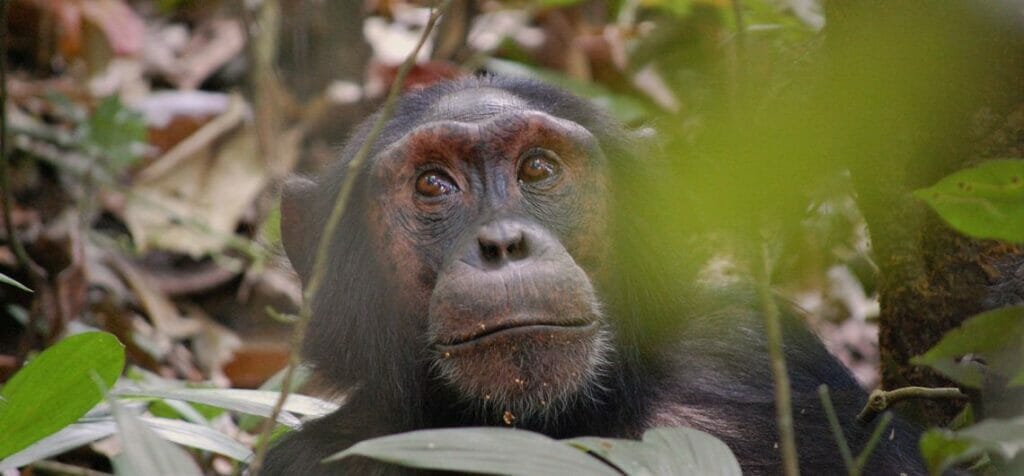
Located in western Uganda, Kibale National Park is renowned for its dense tropical rainforests and rich biodiversity. While the park is famous for its population of chimpanzees, it is also a birdwatching paradise, offering a chance to observe a variety of forest species.
The Kibale Forest is home to numerous bird species, including the Green-breasted Pitta, a colorful and elusive bird known for its distinctive call and striking plumage. Other notable inhabitants of the forest include the African Pitta, Yellow-spotted Barbet, and the Great Blue Turaco.
Birdwatchers can explore the park’s network of trails, guided by experienced trackers who are skilled at locating and identifying the diverse bird species. The dense vegetation provides a unique challenge but also offers the opportunity to spot a wide range of forest-dwelling birds, from tiny sunbirds and kingfishers to the impressive African Grey Parrot.
Semuliki National Park: Exploring the Albertine Rift’s Avian Treasures

Nestled within the western arm of the East African Rift Valley, Semuliki National Park is a hidden gem for birdwatchers. This relatively small park boasts a remarkable diversity of bird species, thanks to its location in the Albertine Rift, an area known for its high levels of endemism.
Semuliki National Park is home to several species that are difficult to find elsewhere in Uganda, including the Nkulengu Rail, Congo Serpent Eagle, and the Yellow-throated Cuckoo. The park’s varied habitats, which include grasslands, swamp forests, and riverine zones, provide ideal conditions for a wide range of avian species.
The park’s most renowned attraction is the Sempaya Hot Springs, where visitors can witness the impressive maleo-like displays of the Semuliki’s male Great Blue Turacos. The surrounding forest offers opportunities to spot other species such as the Black Dwarf Hornbill, Crested Malimbe, and the White-bellied Kingfisher.
Exploring Semuliki National Park allows birdwatchers to delve into the unique avian treasures of the Albertine Rift, offering a distinct and rewarding birdwatching experience.
As we journey through Uganda’s top birdwatching destinations, we uncover the incredible diversity of habitats, bird species, and unique experiences that await us. Bwindi Impenetrable National Park, Queen Elizabeth National Park, Murchison Falls National Park, Kibale National Park, and Semuliki National Park each offer a distinct tapestry of avian wonders. Whether you’re captivated by the elusive Albertine Rift endemics, the vibrant waterbirds, or the enchanting forest dwellers, Uganda’s top birdwatching destinations promise an unforgettable adventure for bird enthusiasts of all levels. So pack your binoculars, prepare your checklist, and immerse yourself in the remarkable birdlife that awaits in Uganda’s natural havens.
Tips and Techniques for Birdwatching in Uganda
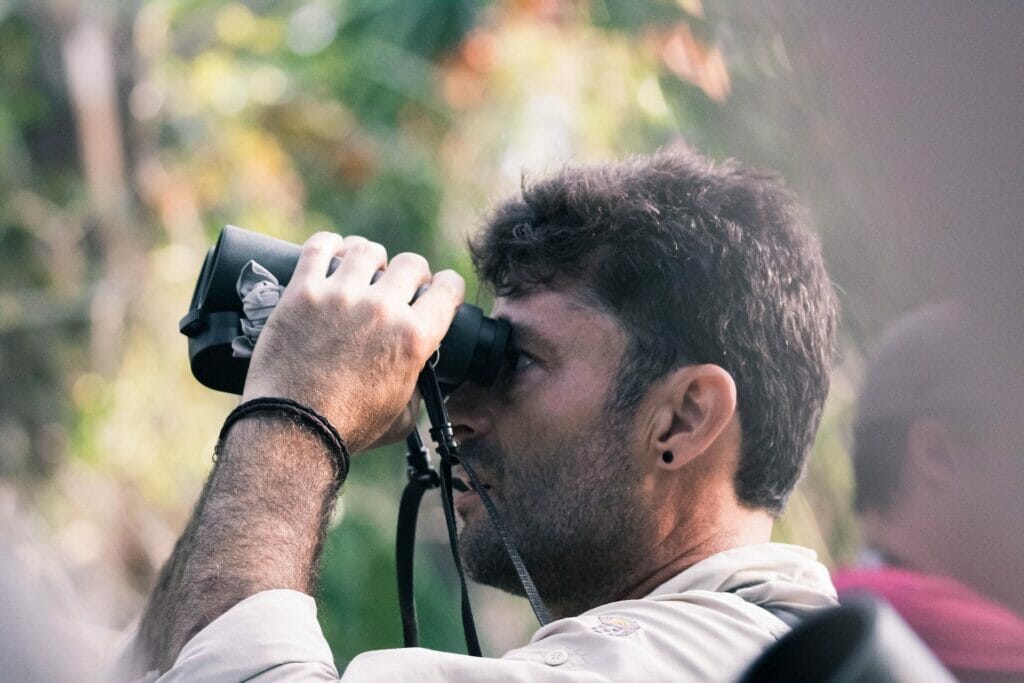
Embarking on a birdwatching adventure in Uganda requires more than just a pair of binoculars and a checklist. To fully immerse yourself in the avian wonders of the country, it is essential to equip yourself with the right knowledge and techniques. Here, we provide valuable tips and insights to enhance your birdwatching experience in Uganda and make the most of your encounters with the country’s diverse bird species.
Essential Birdwatching Equipment to Pack for Uganda
Packing the right equipment is crucial for a successful birdwatching trip in Uganda. Here are some essential items to include in your birding kit:
- Binoculars: Invest in a good pair of binoculars with appropriate magnification and field of view. Opt for binoculars with a magnification between 8x and 10x and a wide field of view for easier tracking and identification of birds.
- Field Guide: Carry a comprehensive field guide specific to the bird species found in Uganda. Look for guides that provide detailed descriptions, illustrations, and range maps to aid in identification.
- Spotting Scope: A spotting scope can be useful for observing birds from a distance, especially for waterbirds or species in inaccessible areas. Pair it with a sturdy tripod for stability.
- Camera and Telephoto Lens: If you are interested in bird photography, bring along a camera with a telephoto lens. Capturing the intricate details of birds will allow you to relive your birdwatching experiences and share them with others.
- Notebook and Pen/Pencil: Keep a birding journal to record your sightings, observations, and notes about behavior, habitat, and calls. This will help you remember and learn from your birdwatching experiences.
- Field Clothing: Dress in comfortable, lightweight, and breathable clothing that offers protection from the sun, insects, and vegetation. Earth-toned or camouflage clothing is recommended to blend in with the surroundings and minimize disturbance to birds.
- Hat, Sunscreen, and Insect Repellent: Protect yourself from the sun’s harmful rays, and apply sunscreen regularly. Use insect repellent to ward off mosquitoes and other biting insects.
- Water and Snacks: Stay hydrated during your birdwatching excursions by carrying an adequate supply of water. Pack energy-boosting snacks to keep you fueled throughout the day.
By packing these essential items, you will be well-prepared to fully enjoy your birdwatching adventures in Uganda.
Field Guide Recommendations for Bird Identification in Uganda
Having a reliable field guide is essential for identifying the diverse bird species found in Uganda. Here are a few highly recommended field guides for bird identification in the country:
- “Birds of East Africa” by Terry Stevenson and John Fanshawe: This comprehensive guide covers Uganda, Kenya, Tanzania, Rwanda, and Burundi, making it a valuable resource for birdwatchers exploring the East African region.
- “Field Guide to the Birds of Uganda” by Jonathan Rossouw and Ian Sinclair: This guide focuses specifically on Uganda’s bird species and provides detailed descriptions, illustrations, and range maps, making it an excellent companion for birdwatchers in the country.
- “Birds of Africa South of the Sahara” by Ian Sinclair and Peter Ryan: Although not specific to Uganda, this guide covers a wide range of African bird species and can be a valuable resource for birdwatchers interested in the broader avian diversity of the continent.
These field guides offer comprehensive information on bird identification, behavior, and distribution, allowing birdwatchers to make accurate identifications and learn more about the unique characteristics of Uganda’s avian inhabitants.
Understanding Bird Calls and Songs in Uganda
Bird calls and songs are essential for both bird identification and the overall enjoyment of birdwatching. Learning to recognize and interpret these vocalizations can greatly enhance your birdwatching experience in Uganda.
One way to familiarize yourself with bird calls and songs is to listen to recordings or use mobile applications that feature bird sounds. Many field guides also include audio recordings, allowing you to compare the sounds you hear in the field with those in the guide.
When listening to bird calls and songs, pay attention to the rhythm, pitch, and patterns. Some calls may be distinctive and easily recognizable, while others may require more practice to differentiate. By honing your listening skills, you can identify birds even when they are hidden from view or when visibility is poor.
Birdwatchers often use mnemonic devices or associations to remember bird songs. These can be phrases or descriptions that resemble the sounds produced by specific birds. For example, the call of the African Fish Eagle is often described as a melodious “go-away, go-away,” while the African Grey Parrot’s vocalizations are reminiscent of human speech.
Practice and familiarity with bird calls and songs will allow you to identify birds by sound alone, adding an extra dimension to your birdwatching encounters in Uganda.
Bird Photography Tips and Etiquette in Uganda
Bird photography is a popular pursuit among birdwatchers, allowing them to capture the beauty and behavior of birds in stunning detail. Here are some tips to enhance your bird photography experience in Uganda:
- Respect the Birds: Prioritize the well-being of the birds and their habitats. Keep a safe distance and avoid disturbing or stressing the birds for the sake of a photograph. Be mindful of nesting areas and sensitive habitats, and never put the birds’ welfare at risk for the sake of a shot.
- Patience and Observation: Observe the behavior and movements of birds to anticipate their actions and capture unique shots. Patience is key, as it may take time to get the perfect shot. Avoid sudden movements or loud noises that could startle or disrupt the birds.
- Lighting and Composition: Pay attention to lighting conditions to capture the best possible images. Soft, diffused lighting is often ideal for bird photography. Experiment with different compositions to create visually appealing images, considering elements such as background, depth of field, and framing.
- Use Appropriate Equipment: Invest in a camera body and telephoto lens suitable for bird photography. A lens with a long focal length, such as 300mm or higher, will allow you to capture birds from a distance without causing disturbance. Consider using a tripod or monopod for stability, especially when using longer lenses.
- Learn Bird Behavior: Understanding bird behavior can help anticipate photo opportunities. Study the habits and movements of the birds you wish to photograph, such as feeding patterns, courtship displays, or nesting behaviors. This knowledge will enable you to position yourself for the best shots.
- Post-Processing: Edit your photos to enhance their quality and bring out the natural beauty of the birds. Adjustments to exposure, contrast, and sharpness can help refine your images and showcase the intricate details of the birds’ plumage.
Remember that the welfare of the birds should always come first. Practice responsible photography and follow ethical guidelines to ensure both the safety of the birds and the preservation of their natural habitats.
Responsible Birdwatching Practices and Conservation Initiatives in Uganda
Responsible birdwatching involves minimizing the impact on birds and their habitats while actively supporting conservation efforts. By adopting sustainable practices and participating in conservation initiatives, birdwatchers can contribute to the long-term preservation of Uganda’s avian biodiversity. Here are some ways to engage in responsible birdwatching:
- Follow Local Regulations: Familiarize yourself with the rules and guidelines set by national parks, reserves, and other protected areas in Uganda. Adhere to designated trails, respect restricted areas, and obtain the necessary permits or passes for birdwatching activities.
- Minimize Disturbance: Keep a safe distance from birds to avoid causing stress or disruption to their natural behaviors. Use binoculars or spotting scopes instead of approaching too closely. Avoid making loud noises or sudden movements that could startle the birds.
- Do Not Feed Wildlife: Feeding birds or other wildlife can disrupt their natural foraging habits and dependency on natural food sources. It can also create an unhealthy reliance on human-provided food, leading to imbalances in the ecosystem. Appreciate birds in their natural habitat without interfering with their feeding patterns.
- Support Local Communities and Conservation Efforts: Choose birdwatching tour operators and accommodations that actively support local communities and conservation initiatives. By contributing to the local economy and supporting conservation organizations, you help ensure the long-term sustainability of birdwatching and conservation efforts in Uganda.
- Educate and Inspire: Share your knowledge and experiences with others to raise awareness about the importance of bird conservation. Engage in citizen science projects, contribute to bird monitoring programs, and participate in educational initiatives that promote birdwatching and conservation in Uganda.
By adopting responsible birdwatching practices and actively supporting conservation initiatives, birdwatchers can contribute to the preservation of Uganda’s avian biodiversity for future generations to enjoy.
As you embark on your birdwatching adventures in Uganda, remember to equip yourself with the essential equipment, familiarize yourself with bird calls and songs, practice ethical bird photography, and engage in responsible birdwatching practices. By doing so, you will not only maximize your birdwatching experience but also contribute to the conservation of Uganda’s remarkable birdlife.
Conservation Initiatives and Ecotourism in Uganda
Conservation initiatives and ecotourism play a vital role in safeguarding Uganda’s rich avian biodiversity and natural ecosystems. The government of Uganda, non-profit organizations, local communities, and various stakeholders are actively involved in implementing measures to protect and preserve the country’s birdlife. Through responsible tourism practices and community involvement, these initiatives contribute to the sustainability of Uganda’s avian treasures and offer opportunities for visitors to engage with conservation efforts firsthand.
Important Conservation Initiatives in Uganda
Uganda is committed to the conservation of its avian biodiversity through various initiatives aimed at protecting birds and their habitats. Some of the key conservation programs and initiatives in the country include:
- Protected Areas and National Parks: Uganda has established numerous protected areas and national parks to safeguard critical habitats for birds. These areas, such as Bwindi Impenetrable National Park, Queen Elizabeth National Park, and Murchison Falls National Park, provide sanctuary for vulnerable and endangered bird species and help maintain the ecological balance.
- Bird Monitoring and Research: Ongoing bird monitoring and research projects are conducted in Uganda to gather data on population trends, distribution, and behavior of bird species. These studies contribute to our understanding of avian ecology and inform conservation strategies and policies.
- Environmental Education and Awareness: Educational programs are conducted to raise awareness among local communities, stakeholders, and visitors about the importance of bird conservation. These initiatives focus on promoting sustainable practices, reducing human-wildlife conflicts, and fostering a sense of stewardship towards Uganda’s avian biodiversity.
- Community-based Conservation Programs: Engaging local communities in conservation is crucial for the long-term success of bird conservation efforts. Community-based initiatives involve training local guides, supporting sustainable livelihoods tied to birdwatching tourism, and empowering communities to actively participate in conservation activities.
- Conservation Partnerships: Uganda collaborates with international organizations, research institutions, and non-profit conservation groups to strengthen conservation efforts. These partnerships facilitate knowledge exchange, capacity building, and funding support for conservation projects.
These conservation initiatives collectively contribute to the preservation of Uganda’s avian treasures and ensure the sustainable management of its natural resources.
The Role of Ecotourism in Bird Conservation
Ecotourism in Uganda plays a pivotal role in bird conservation by providing economic incentives for sustainable practices and habitat preservation. Birdwatching tourism contributes to local economies, raises awareness about the value of birds and their habitats, and fosters a sense of appreciation and responsibility towards conservation.
By engaging in responsible birdwatching practices, visitors support the conservation of bird habitats in several ways:
- Financial Support: Birdwatching tourism generates revenue that can be directed towards conservation initiatives, including habitat restoration, anti-poaching efforts, and community development projects. The funds raised through ecotourism activities help support the maintenance and protection of national parks, reserves, and other protected areas.
- Conservation Education: Ecotourism provides opportunities for visitors to learn about the importance of bird conservation through guided tours, interpretive signage, and interactions with local guides. By educating visitors about the significance of birds and their habitats, ecotourism fosters a greater understanding and appreciation for conservation efforts.
- Sustainable Livelihoods: Ecotourism initiatives create employment opportunities for local communities, reducing the dependence on unsustainable practices that may harm bird habitats. By providing alternative livelihoods tied to birdwatching tourism, local communities are incentivized to protect and conserve the natural resources on which their livelihoods depend.
- Monitoring and Research: Birdwatching tourists often contribute to citizen science projects by reporting their bird sightings and participating in data collection efforts. These contributions help enhance scientific knowledge, monitor bird populations, and inform conservation strategies.
- Promotion of Conservation Ethics: Responsible birdwatching practices promoted through ecotourism encourage visitors to minimize their impact on bird habitats. By adhering to ethical guidelines, such as staying on designated trails, minimizing disturbance, and respecting wildlife, birdwatchers contribute to the preservation of bird species and their habitats.
Through the combined efforts of conservation initiatives and ecotourism, Uganda is making significant strides in protecting its avian biodiversity and promoting sustainable practices for the benefit of both birds and local communities.
Sustainable Tourism Practices in Uganda
To ensure the long-term sustainability of tourism and bird conservation in Uganda, it is crucial to embrace sustainable tourism practices. Here are some key principles to consider when planning your birdwatching trip:
- Support Local Communities: Choose accommodations, tour operators, and services that prioritize sustainable practices, community involvement, and fair economic benefits for local communities. By supporting local businesses, you contribute to the well-being of communities and the conservation of bird habitats.
- Minimize Environmental Impact: Practice responsible waste management, minimize energy and water consumption, and follow designated trails and guidelines within protected areas. Leave no trace of your visit and respect the natural environment to minimize your impact on bird habitats.
- Respect Wildlife: Adhere to ethical guidelines for wildlife viewing, including maintaining a safe distance from birds, avoiding the use of flash photography, and refraining from touching or disturbing birds or their nests. Respect the natural behaviors of the birds and observe from a distance to prevent stress or disruption.
- Support Conservation Initiatives: Consider volunteering with local conservation organizations, participating in bird monitoring programs, or contributing to community-based conservation projects during your visit. These initiatives provide hands-on experiences and allow you to actively contribute to bird conservation efforts in Uganda.
- Engage in Cultural Exchanges: Embrace the rich cultural heritage of Uganda by engaging with local communities, respecting their traditions, and learning about their relationship with birds and the environment. By fostering cultural understanding, you contribute to the overall sustainability of tourism and conservation.
By adopting sustainable tourism practices, you can make a positive difference in bird conservation efforts while enjoying a meaningful and immersive birdwatching experience in Uganda.
As we explore the conservation initiatives, the role of ecotourism, and sustainable tourism practices in Uganda, it becomes evident that responsible travel is the key to preserving the country’s avian treasures. By supporting conservation initiatives, engaging with local communities, and practicing sustainable tourism, we can ensure that future generations will continue to experience the remarkable birdlife and natural wonders that Uganda has to offer. Let us embrace these principles and embark on our birdwatching adventures with a deep sense of appreciation and commitment to the conservation of Uganda’s avian biodiversity.
Book Your Next Uganda Birdwatching Tour With Kikooko Africa Safaris
From the dense rainforests of Bwindi Impenetrable National Park to the vast savannahs of Queen Elizabeth National Park, Uganda’s diverse habitats provide a haven for an incredible array of bird species, including rare endemics, migratory visitors, and iconic waterbirds.
Uganda’s commitment to conservation, coupled with responsible tourism practices, ensures the preservation of its avian treasures and the sustainable management of its natural resources. From protected areas and research initiatives to community-based conservation programs, Uganda’s dedication to bird conservation is evident. By supporting these efforts and engaging in responsible birdwatching practices, visitors can actively contribute to the long-term sustainability of Uganda’s avian biodiversity.
So, whether you are an avid birder seeking elusive species or a nature enthusiast looking to immerse yourself in the beauty of Uganda’s natural landscapes, let the enchanting melodies, vibrant plumages, and breathtaking landscapes captivate your senses. Plan your birdwatching adventure, pack your binoculars, and embark on a journey that will leave you with memories to cherish and a profound appreciation for the avian wonders of Uganda. Send our team a message and we’d be happy to begin planning your next birdwatching tour in Uganda.

